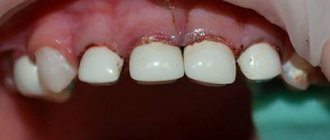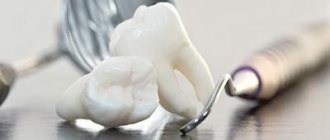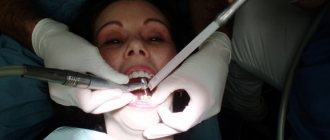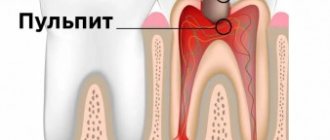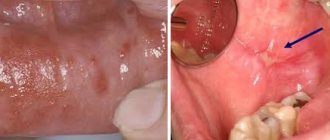First of all, we note that the price for treating pulpitis of a three-canal tooth really depends on the number of these very root canals in it, and here the general rule is this: the more there are, the more expensive the treatment procedure usually costs. And not only more expensive, but, in addition, with a large number of roots, a number of nuances of endodontic procedures often arise, which we will talk about in more detail later.
On a note
Pulpitis is a disease in which inflammation of the so-called dental “nerve” (pulp) occurs. Large molars (molars) most often have three canals, each of which contains a neurovascular bundle. When an inflammatory process occurs in the pulp, it swells and is compressed, as a result of which a person can feel severe pain.
Pulpitis requires mandatory treatment: you should not expect that everything will somehow resolve and the pain will go away on its own, as sometimes happens in the case of pain during caries. The pain may indeed disappear when the “nerve” completely dies, but then it will begin to decompose right inside the tooth, and without appropriate treatment this will not lead to anything good.
Treatment of pulpitis of a three-canal tooth, in contrast to a single-canal one, is often technically more difficult, so in order to carry out high-quality work, the doctor has to spend more effort and time, and also actively apply the achievements of modern dentistry.
Today, in most clinics, three-channel pulpitis is almost always treated by extirpation - removing the nerve from all canals and filling them at the final stage of intracanal treatment.
This is interesting
In the upper wisdom teeth there are the most unpredictable variations in the number and location of roots and canals. As a rule, doctors are faced with one-, two- and three-canal eighth teeth, but there have also been cases of 4 and even 5-root teeth with up to 8 full canals!
Three-channel pulpitis in most dental clinics is treated in two visits. For these purposes, the so-called vital extirpation technique is well suited, when, under local anesthesia, the pulp is removed from all three canals and they are filled, followed by the placement of temporary filling material on the tooth. And on the second visit, the permanent filling is successfully installed.
Let's now see how this happens in practice.
First visit:
- tooth pain relief;
- preparation of carious softened tissues with a turbine tip, removal of necrotic and pigmented dentin;
- washing with antiseptics;
- opening good access to the mouths of three canals;
- expansion of mouths;
- rubber dam application;
- extirpation (extraction) of pulp from all three canals using pulp extractors;
- passing the canals with files, measuring their length, expanding with K-files, H-files, machine instruments with constant irrigation (washing) of the canal system with sodium hypochlorite solution;
- the use of EDTA preparations for poorly traversed canals;
- drying of canals, control measurement of their lengths;
- filling the canals using the method of cold lateral condensation of gutta-percha pins with paste or using the Termafil system for obturation;
- placement of a temporary filling or temporary restoration of a tooth;
- control image (x-ray).
Second visit:
- reprocessing of the tooth;
- placement of a permanent filling made from a light-curing composite or other imported material (an example is shown in the photo below).
Sometimes pulpitis of a three-rooted tooth is treated in three visits or even more. This depends on the chosen technique, the doctor’s tactics, the level of his professional skills and sometimes on the difficulties that arise during intracanal treatment.
If it is impossible to immediately remove the pulp from the canals, the dentist places a devitalizing drug on the opened pulp chamber in order to “kill the nerve” for the next appointment. Accordingly, this increases the treatment of three-channel pulpitis by one visit.
In Soviet times, even single-channel pulpitis was treated with “arsenic” for a period of 24 hours. This practice is no longer acceptable at the current level of development of dentistry. Treatment of pulpitis of a single-canal tooth, as well as a double-canal one, is almost always carried out in one visit (with rare exceptions).
Large molars (mainly the lower ones), due to the structural features of the jaw and the location of the nerves that determine the sensitivity of the tooth, sometimes may not be “frozen” to such an extent that the nerve can be removed immediately, that is, pain sensitivity remains. Therefore, the way out of this situation is the preliminary use of pulp-killing pastes (popularly they are still called “arsenic,” although modern preparations have not contained arsenic for a long time).
It is also useful to read: Symptoms of pulpitis: what is important to know in case of severe tooth pain
On a note
In a number of clinics, treatment of pulpitis is always carried out in one visit, regardless of the number of canals: they are filled, and a permanent filling is immediately installed on the tooth. Studies have shown that this practice often leads to long-term negative consequences, since the material introduced into the canals must first harden. In construction, work does not begin until the foundation hardens, as the consequences can be disastrous - and the situation is the same here. That is why it is recommended to treat pulpitis in at least two visits.
What is three-channel pulpitis?
The number of canals in each tooth varies, usually one or two, in molars – most often three. There are record-breaking patients in whom up to eight processes were discovered during treatment. Three-channel pulpitis, as the name implies, is diagnosed in a tooth that has three channels. Inflammation of the pulp or, as is often said, the dental nerve, manifests itself in severe pain. It can be paroxysmal, worse at night, radiating to the ear or temple. It is impossible and dangerous to endure such acute pain for a long time. According to experts, pulpitis is the reason every fifth patient visits the clinic.
Why do they trust us?
Our dentistry uses modern scientific methods in dental treatment. Over 16 years of impeccable work, we have helped more than 20,000 patients to promptly cure oral diseases, maintain healthy gums and a beautiful smile.
We have our own diagnostic room with modern digital equipment and a dental laboratory. You will receive all the necessary examinations, treatment and prosthetics in one place.
The clinic employs successful specialists with highly professional experience in dentistry. Doctors annually take special courses, improve their qualifications, and participate in international symposiums.
We see the following specialists:
- dentist-therapist;
- orthopedic dentist;
- orthodontist;
- dental surgeon;
- periodontist;
- pediatric dentist;
- Dental Technician;
- radiologist.
Specifics of treatment of three-channel pulpitis
Treatment of pulpitis of a 3-canal tooth is considered complex and must be carried out with special care. In severe cases, several visits to the dentist are required.
- The doctor spends an hour to an hour and a half on a multi-channel tooth;
- under a microscope - about two hours.
This is due to the fact that 3-channel pulpitis requires treatment in each process.
Treatment under a microscope
Treatment of three-channel pulpitis is carried out by a specialist in the field of endodontics. Work in the dental canals is best done under a dental microscope. This method has many advantages.
Advantages of treatment under magnification
- The dental canals are very thin, tortuous, no more than 1 mm in diameter. The microscope magnifies them to 2.5-3 cm. The dentist does not treat blindly, under magnification he clearly sees all the branches and foci of inflammation. Treatment of pulpitis of the 3rd canal takes place in good lighting.
- The patient lies down, the doctor looks not into the mouth, but into the microscope camera. This has a calming effect on dentophobes.
- The microscope reveals the most difficult to reach areas for the doctor. This is especially true for patients who have hidden dental canals that are not visible to the human eye. And during endodontic treatment, it is important to remove all foci of inflammation to avoid relapse.
Causes of pulpitis
- caries.
Pathogenic microflora actively multiply, releasing toxins; - dentist mistakes.
The defects are filled with low-quality material, microorganisms contribute to the destruction of the organ. When drying, due to excessive use of air, a dentin burn may occur (aseptic inflammation that develops without bacteria); - the presence of a chronic source of infection
- sinusitis/tonsillitis; - with periodontitis,
the infection penetrates from deep periodontal pockets, provoking the development of retrograde pulpitis; - injuries
- bruise, broken parts of the crown, chipped enamel, fracture; - increased organ wear
due to osteoporosis and diabetes.
Stages of treatment for 3-channel pulpitis
Treatment of pulpitis of one- and two-canal teeth, as a rule, occurs in one appointment. Three channels are put in order in two visits. Some clinics offer to treat pulpitis of the 3rd canal tooth in one go. There is no need to take risks, it is better to do everything according to the rules.
To treat three-channel pulpitis, the vital extirpation method is used. The pulp is removed, the canals are thoroughly cleaned, disinfected and sealed. Let's look at each stage of treatment of root pulpitis 3 in detail.
Stages of treating pulpitis without a microscope
- Pain relief using local anesthesia.
- Removing softened tissue and washing the cavity with an antiseptic.
- Expansion of the mouths of three canals and removal of pulp.
- Flushing the canals with sodium hypochlorite as an antimicrobial treatment.
- Drying and filling the canals and installing a temporary filling on the crown of the tooth.
- Evaluation of treatment results using control x-rays.
The main treatment takes place during the first appointment. A break is needed so that the filling material in the canals hardens well. The second stage will take less time: the tooth will be processed again and a permanent filling will be placed.
The number of appointments may increase to three if it is impossible to immediately remove the pulp from the canals. In this case, the nerve will be “killed” by a special paste. It will be added to the cavity and left until the next visit. Soviet patients said this: “They put arsenic.” This substance is not used in modern toothpastes, but many, out of habit, believe that the dental nerve is removed with the help of arsenic.
Prices for the treatment of acute and chronic dental pulpitis
To find out the cost of treating pulpitis, sign up for a consultation at Dr. Razumenko’s clinic by calling: 8 (495) 380-01-38.
| Code no. | NAME OF PROCEDURES | Unit of measurement | Cost, rub. |
| Mechanical processing of channels | |||
| 401 | Mechanical treatment of the canal with hand tools | 1 500,00 | |
| 402 | Mechanical canal processing (Profail, pro-taper) | 2 000,00 | |
| 404 | Filling with temporary (therapeutic) material | 1 000,00 | |
| 405 | Canal filling using lateral condensation method | 1 500,00 |
* The prices indicated on the website are not a public offer. The exact cost can only be determined by visiting a doctor.
Prices for treatment in Moscow full price list
Share on social media networks:
Article Expert:
Ustinova Elena Fedorovna
Doctor of the highest category. Root canal treatment (complex, repeated retreatment), microprosthetics with ceramic restorations.
Work experience 15 years
Can three-channel pulpitis go away on its own?
Pulpitis of a three-canal tooth, of course, will not go away from lack of treatment and will become chronic. The nerve will die under the influence of microbes, the pain will go away, and the patient will deceptively think that the problem is solved. But this will turn out to be a temporary calm before the storm. The nerve will decompose inside the tooth, there will be even more microbes, inflammation will affect the surrounding tissues, and ultimately it will all end in the formation of a cyst. It will be very difficult to save such a tooth from removal. Treatment of pulpitis of a 3-canal tooth should be immediate.
Features of endodontic treatment
Since childhood, for many, going to the dentist is inevitably associated with pain. Basically, this is just a psychological factor caused by the visual perception of the dental office almost like a hospital operating room. Most dental procedures are painless thanks to a combination of advanced treatment techniques and the use of effective local anesthesia. If we talk about endodontic dental treatment, it is somewhat painful, but this, firstly, is logically explainable, and secondly, the pain will be present for a short period. When a focus of infection appears in our body, pain is a natural reaction and a signal to action. This is inherent in nature itself. In the case of endodontics, we are talking about inflamed nervous tissue, which, of course, creates unpleasant sensations. However, an experienced dentist, using high-quality anesthetics, is able to carry out all the necessary actions with minimal discomfort for you. For some time after the end of treatment, increased sensitivity of the tooth to external influences cannot be ruled out. This feature does not appear for long and is easily eliminated with available medications.
How much will treatment cost in Moscow clinics?
Treatment of pulpitis of a three-channel tooth will cost the patient a lot. The price in Moscow dentistry starts from 5,000 (without a filling on the crown) - 7,000 rubles (with the simplest filling) and reaches 13,000 rubles. Treatment under a microscope increases the cost of 3-channel pulpitis to 21,000 rubles. The prices for treatment of pulpitis are influenced by the quality of the instruments used by the doctor, the choice of anesthesia, means for disinfecting the canals, as well as the material from which the filling is made. All this needs to be taken into account before going to the doctor.
Reviews
Kamila
Very good place and professional doctors. Respectful, attentive attitude towards patients. They are able to treat very well, even complex cases. Many thanks for your professionalism, patience and high personal qualities.Igor
Not long ago I came to treat three-channel pulpitis. From experience in other dentistry, I know that anything can happen. I was very worried about how everything would happen this time. I want to say that the treatment went just fine. I fully felt the professionalism of the doctors. I am very pleased with my visit to this dentistry!
Treatment of pulpitis under a microscope with our experienced endodontists:
- extended warranty
- saving 98% of teeth with cysts and periodontitis - no removal
- treatment using modern equipment under magnification and a microscope (fillings last 10 years or longer)
- use only certified materials from Germany, USA, Japan, Israel
- thousands of positive reviews
- high-quality diagnostics , and not treatment “by eye”
- detailed treatment plan with no hidden fees
- quality treatment at prices in the residential area of Yasenevo
Complications and prevention of pulp diseases
In the hands of an experienced dental surgeon, there is reason to rest in peace and confidence in a favorable outcome of treatment. After all, problems often arise due to insufficient qualifications of the doctor, ranging from incorrect diagnosis, as a result of which the problem is not fully identified and the infection continues to remain in one of the canals, ending with unprofessional installation of filling materials, due to which the infection can re-enter the canal. Unexpected damage to tooth tissue may also occur during treatment. To avoid complications (mainly in complex cases), antibiotics are prescribed in parallel with treatment.
The best prevention (besides regular visits to the dentist - at least once every six months) is simple and accessible to everyone: brushing your teeth using a suitable toothbrush and recommended toothpastes; rejection of bad habits; reducing consumption of foods high in sugar - most of these recommendations are appropriate both for the prevention of dental disease and for simply following the principles of a healthy lifestyle.
How is pulpitis diagnosed?
Treatment of pulpitis in Moscow at the Novodenta clinic is carried out by a doctor after examining the oral cavity and the results of the examination.
The following methods will help to distinguish pulpitis from other diseases, in particular deep caries:
- thermometry – determines how the tooth reacts to temperature stimuli;
- electroodotodiagnostics – exposure of the tooth to a weak current;
- radiography - determines the depth of damage to the pulp and bone structure.
The results obtained allow the doctor to determine the degree of damage to the pulp and select the optimal treatment.
How do human teeth work?
The structure of the human tooth cannot be called complex. The visible part of the tooth (crown) is located above the gum, and inside the gum are the roots of the tooth. They serve as attachments to the jaw bones. As we said at the beginning of the article, inside the tooth there is a canal (root) containing blood vessels, as well as nervous tissue - together they are called the pulp. Thanks to nerve endings, teeth are able to signal us about the occurrence of infections or aggressive influence of external factors. The outside of the tooth is covered with a protective layer – enamel. The hard tissue of the tooth itself is called dentin. Dentin and enamel are mainly composed of mineral substances (96 and 70 percent, respectively).
What are the symptoms of the disease
Clinical signs of pulpitis are always pronounced, accompanied by severe toothache, inflammation and swelling.
In dental practice, there are several forms and stages of pulpitis:
- Acute pulpitis. Accompanied by acute pain, which manifests itself periodically, more often after eating cold or hot food.
- Purulent pulpitis. There is pronounced inflammation, which passes from serous to purulent. The pain is pronounced, throbbing, shooting.
- Chronic form. It develops in the absence of timely treatment of acute pulpitis and is characterized by periods of remission and exacerbation. The pain at this stage is aching, appears when eating cold or hot food, and lasts no more than 10-15 minutes. During the period of exacerbation, the symptoms are the same as in the acute form.
The acute and purulent form of pulpitis has the most pronounced symptoms. Sometimes the pain is so strong that it radiates to other parts of the body: neck, head, other teeth. In addition, there is swelling of the cheeks, increased bleeding of the gums, tissue necrosis, and, as a result, periodontitis. At the stage of complete tooth destruction, it is impossible to save the tooth, and the only treatment option is pulp removal.
